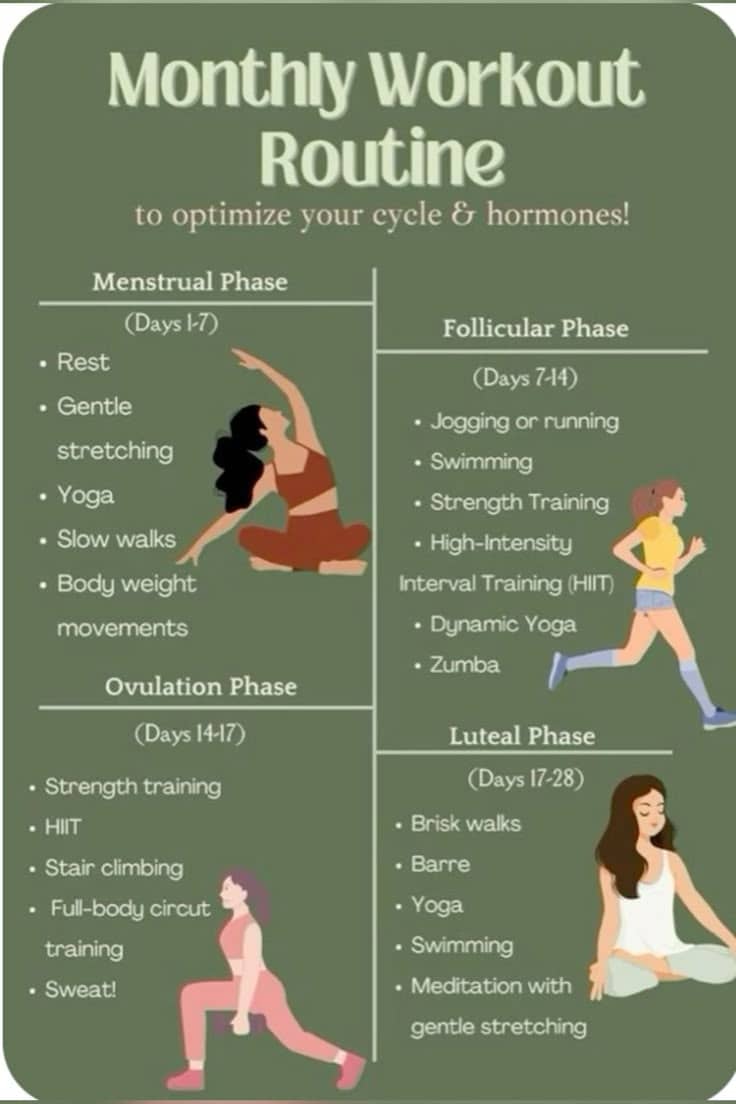The Ultimate Guide to Cycle-Synced Workouts: Optimize Your Fitness with Your Menstrual Cycle
Introduction: Why Your Menstrual Cycle Should Dictate Your Workout Routine
In recent years, the concept of “cycle syncing” has gained significant traction in the fitness and wellness communities. But what exactly does it mean, and why should you care?
Your menstrual cycle isn’t just about your period—it’s a complex hormonal dance that affects everything from your energy levels to your metabolism, strength, and recovery. By understanding these fluctuations and adjusting your workouts accordingly, you can:
- Maximize performance during high-energy phases
- Prevent burnout and injuries
- Support hormonal balance naturally
- Achieve better results with less effort
This comprehensive guide will walk you through each phase of your cycle, explaining the hormonal changes and providing tailored workout recommendations. Whether you’re a fitness enthusiast or just starting your journey, this approach will help you work smarter, not harder.
Understanding the Four Phases of Your Menstrual Cycle
Before diving into workouts, let’s break down the four key phases of a typical 28-day cycle (note: cycle lengths vary—adjust as needed for your body):
- Menstrual Phase (Days 1-7): Your period occurs as the uterine lining sheds.
- Follicular Phase (Days 7-14): Your body prepares for ovulation.
- Ovulation Phase (Days 14-17): An egg is released—peak fertility window.
- Luteal Phase (Days 17-28): Your body prepares either for pregnancy or menstruation.
Each phase comes with distinct hormonal profiles that significantly impact how you feel and perform.
Phase 1: Menstrual Phase (Days 1-7) – The Recovery Phase
Hormonal Landscape:
- Estrogen and progesterone at their lowest
- Possible fatigue, cramps, and lower energy
Why Rest Matters
This is your body’s natural recovery time. Pushing too hard can lead to increased inflammation and prolonged recovery. Instead, focus on gentle movement that supports circulation and eases discomfort.
Recommended Workouts:
- Gentle Yoga
- Focus on poses that relieve cramps (child’s pose, cat-cow)
- Avoid intense inversions if you’re feeling dizzy
- Slow Walks
- 20-30 minutes of leisurely walking
- Great for reducing bloating and improving mood
- Bodyweight Movements
- Light Pilates or stretching routines
- Avoid heavy resistance training
Nutrition Tip: Increase iron-rich foods (spinach, lentils) to combat blood loss.
Phase 2: Follicular Phase (Days 7-14) – The Energy Surge
Hormonal Landscape:
- Estrogen rises steadily
- Testosterone begins to increase
- Energy and stamina improve
Why This Is Your Power Phase
With rising estrogen, your body is primed for endurance and strength. This is the perfect time to challenge yourself with higher-intensity workouts.
Recommended Workouts:
- Strength Training
- Focus on progressive overload (increase weights gradually)
- Ideal for building lean muscle
- HIIT (High-Intensity Interval Training)
- Sprint intervals, jump squats, burpees
- Shorter rest periods feel easier now
- Cardio (Running, Swimming, Cycling)
- Take advantage of increased endurance
- Dynamic Yoga or Dance (Zumba, Barre)
- Fun ways to stay active
Pro Tip: This is the best time to try new workouts or set personal records!
Phase 3: Ovulation Phase (Days 14-17) – Peak Performance
Hormonal Landscape:
- Estrogen and testosterone peak
- Highest energy, strength, and confidence
Why You Feel Unstoppable
This is your biological prime time—your body is at its strongest and most resilient. Capitalize on this window for high-intensity training.
Recommended Workouts:
- Heavy Strength Training
- Deadlifts, squats, bench press
- Aim for lower reps with heavier weights
- HIIT & Sprints
- Tabata workouts, hill sprints
- Stair Climbing or Plyometrics
- Explosive movements feel easier now
- Full-Body Circuit Training
- Combine strength and cardio for max efficiency
Caution: While energy is high, avoid overtraining—listen to your body’s signals.
Phase 4: Luteal Phase (Days 17-28) – The Slowdown
Hormonal Landscape:
- Progesterone dominates
- Energy dips, PMS symptoms may appear
Why Lower Intensity Works Best
Higher progesterone increases fatigue and reduces recovery speed. Intense workouts may feel harder and increase cortisol (stress hormone).
Recommended Workouts:
- Brisk Walking or Light Jogging
- Maintains activity without draining energy
- Yoga (Restorative or Yin)
- Reduces stress and supports relaxation
- Swimming or Water Aerobics
- Gentle on joints, great for bloating
- Barre or Pilates
- Focuses on controlled movements
- Meditation + Stretching
- Helps with mood swings and sleep
Nutrition Tip: Increase magnesium (dark chocolate, nuts) to ease PMS.
Advanced Tips for Cycle-Syncing Success
- Track Your Cycle
- Use apps like Flo, Clue, or Apple Health.
- Adjust Nutrition
- More carbs in the luteal phase for energy.
- Protein-rich meals post-ovulation for recovery.
- Prioritize Sleep
- Especially in the luteal phase when fatigue is higher.
- Listen to Your Body
- Some cycles vary—flexibility is key!
Common Questions About Cycle-Synced Workouts
Q: What if my cycle is irregular?
A: Focus on symptoms rather than days. For example, if you feel fatigued (like the luteal phase), opt for lower-intensity workouts.
Q: Can I still lose weight with this approach?
A: Yes! Aligning workouts with your cycle can actually enhance fat loss by optimizing hormone balance.
Q: Do I have to skip intense workouts entirely during my period?
A: Not necessarily—some women feel fine doing moderate exercise. The key is to adjust based on how you feel.
Final Thoughts: Work With Your Body, Not Against It
Cycle-syncing isn’t about restrictions—it’s about empowerment. By honoring your body’s natural rhythms, you can:
✅ Reduce burnout and injuries
✅ Improve long-term fitness results
✅ Enhance overall well-being
Ready to try it? Save this guide and start tracking your cycle today!
By following this science-backed approach, you’ll transform your fitness routine and feel better throughout your entire cycle. Happy training! 🌸💪










